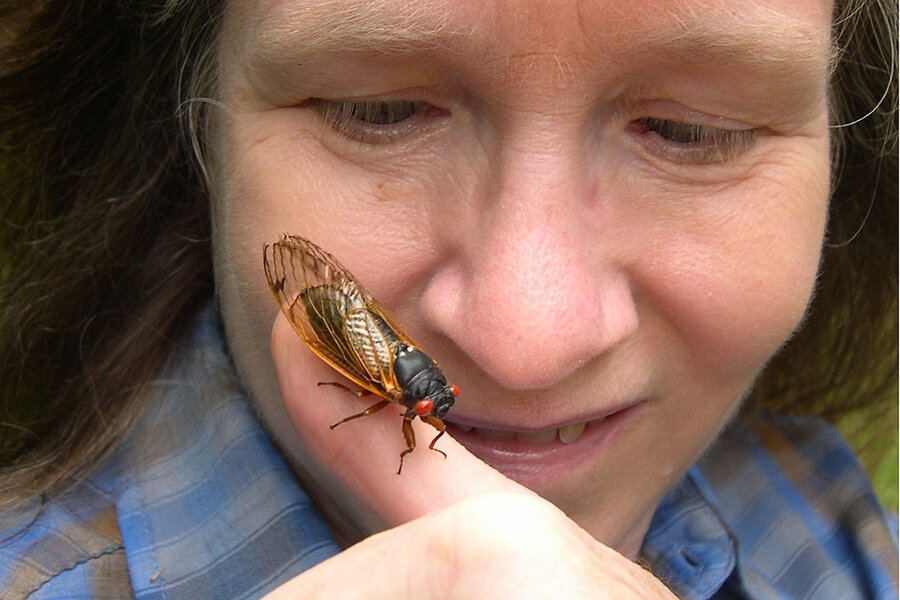Bug-eyed about invading cicadas? They might teach you some life lessons.
Loading...
| Laurel, Md.
Billions of boisterous cicadas are about to burst forth in the eastern United States, and Nancy Hinkle is getting ready to hop in her car.
Not to get away from them. To study and observe them in awe.
There are so many unknowns about these buzzing, 17-year periodical bugs, says Dr. Hinkle, a professor of entomology at the University of Georgia. Among them: “How do [the bugs] synchronize their emergence?” and “How do they know that it’s been 17 years and they should all emerge at the same time?”
Why We Wrote This
“All I really need to know I learned from insects.” OK, our reporter didn’t quite say that. But with billions of cicadas bearing down, he’s got the buzz on a way to approach the experience with humility and even wonder.
For many people, the impending swarms may be a source of annoyance or even fear. For her, these open questions enhance her sense of wonder.
“Only by experiencing this for yourself can one appreciate just how amazing the Brood X emergence is,” Professor Hinkle says. “I’m going to have to travel 60 or 70 miles just to be able to see them.”
The rest of us may not fully share her enthusiasm, but entomologists like her say these insects deserve some appreciation – and may even have lessons for humans in our current times.
They won’t eat your flowers or veggie garden. Their locations vary for groups or “broods” that emerge on different cycles, generally east of the Mississippi River. Each brood is identified by a Roman numeral. Brood X, which has been recorded in descriptions dating back to the Colonial era, is expected to appear this month in the District of Columbia and 15 states – and has already been spotted emerging in Georgia this week.
“One of the things that cicadas can teach us is that we’re all connected,” says DeAnna Beasley, an assistant professor and integrative ecologist at the University of Tennessee-Chattanooga, who is eagerly waiting to see if the cicadas will emerge in her part of Tennessee.
And to Michael Raupp, professor emeritus at the University of Maryland, there is an “interesting parallel” between human society’s pandemic cycle from reclusiveness toward reopening and the bugs’ emergence after “living a COVID-like existence for 17 years underground.”
What can we learn from a bug’s life? Here are a few of the lessons we might draw from these small but active insects.
- Work beneath the surface. The 17-year cicadas spend the majority of their lives below ground, fulfilling an important ecological function of aerating the soil. In an age of social media, we, people, would do well to remember that much of life’s work takes place beneath the surface, when there is no buzz, when no one is watching.
- Get out when it is warm. The cicadas emerge once the soil temperatures reach around 64 degrees Fahrenheit several inches down. For the cicadas, buried below ground for years, the surfacing comes in the spring. For those of us who have been hidden inside, perhaps buried in our computer screens, the cicadas remind us to, as Professor Raupp says, “get up and out,” especially when it is warm outside.
- Rise together. The billions of bugs who push up at around the same time do so for a practical reason, survival. When they rise together, predators become overwhelmed. For a world grown accustomed to division and facing significant challenges ahead, the Brood X cicadas’ emergence can remind us to rise together in order to survive.
- Leave your old self behind, come out of your shell. Once out in the open, often after climbing high up in a tree, the cicadas molt, leaving the shell that once provided protection behind. “It’s just their outer shell that they’ve outgrown,” Professor Beasley says. For people who may be struggling to move forward, and attached to their past protective shell, the cicadas offer inspiration. It is only when the shells are gone that they can fly.
- When necessary make some noise. A primary reason the cicadas attract our attention is because of their louder-than-a-lawnmower mating call, which the males make to the females. The bugs don’t spend the majority of their 17-year lives hollering, however. Professor Hinkle calls them “harmless” and “nature’s pruning service,” due to the way their egg-laying habits can affect pencil-thin tree limbs. They’re usually quiet and below the surface. The great noise they make is only for the survival of the species.
So if the bugs bother you this spring, remember, they’ll be gone in a matter of weeks. That boisterous bumble has a purpose – to replenish the earth, so that one of the world’s wonders can come again, to be eyed, examined, and maybe even enjoyed again 17 years hence.







